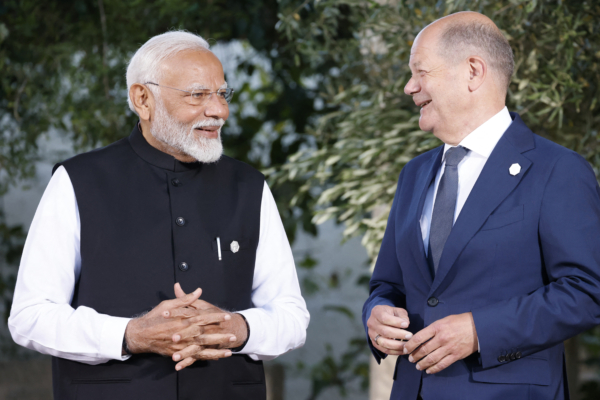German Chancellor Olaf Scholz arrived in India on Thursday, kicking off a three-day visit aimed at deepening ties between Germany and India in an effort to reduce Germany’s reliance on China.
The German government has been working to persuade businesses to reduce their dependence on trade with China, with some suggesting India as a potential alternative. Scholz leads a large delegation comprising several ministers and executives on this visit to seek to establish a strategic partnership with Indian Prime Minister Narendra Modi. The two leaders are scheduled to meet on Friday morning and co-chair a cabinet meeting.
According to Bloomberg, India is planning to order six new submarines to counter China’s expanding naval presence in the Indo-Pacific region. Germany’s Thyssenkrupp AG is competing for this order worth 4,000 crore rupees (approximately 4.8 billion USD).
Since Russia’s invasion of Ukraine in 2022 and the subsequent widespread Western sanctions, India has been seeking to diversify its sources of military hardware. Russia has been India’s largest arms supplier in the past.
Spanish Prime Minister Pedro Sanchez is set to visit India later this month to inaugurate the Airbus SE factory in Gujarat, and Spain’s Navantia shipyard is also competing for the contract to build six new submarines for India.
On Saturday, Scholz will continue his itinerary by visiting the port city of Vasco da Gama on the west coast of India, where two German navy ships – the Baden-Württemberg frigate and the Frankfurt replenishment ship are docked. In September, Germany navigated these two warships through the Taiwan Strait for the first time in 22 years, disregarding warnings from China.
Scholz’s visit comes at a sensitive time for the German economy, which is facing a second year of contraction, amid concerns about potential impacts on German businesses due to trade disputes between the EU and China.
German Economy Minister Robert Habeck stated on Wednesday, “India, as the most populous country in the world, is a key partner for the German economy in the Indo-Pacific region and plays a crucial role in diversifying the German economy.”
“We must reduce critical dependencies and enhance the resilience of German businesses and their supply chains with Asia.”
Germany is already India’s largest trading partner in Europe and the seventh-largest globally. Bilateral trade between the two countries amounted to 22 billion USD in 2020-21 according to Indian government data.
Habeck arrived in India a day earlier to open the biennial German Business Asia-Pacific Conference.
Scholz may also seek Modi’s assistance in addressing obstacles faced by German small and medium enterprises doing business in India. A study by consulting firm KPMG and the German Chamber of Commerce (AHK) identified bureaucracy, corruption, and India’s tax system as major barriers to investment for German companies.
Despite these challenges, German businesses remain optimistic about their future in India, with 82% of respondents expecting revenue growth in the next five years and 59% planning to expand investments, up from 36% in 2021.
In addition to investment, both sides are looking to cooperate in technology transfer.
Given Germany’s aging population, the country’s workforce is projected to decrease by 7 million over the next decade. The current labor shortage has already cost the economy nearly 50 billion euros (around 54 billion USD) this year according to data from the German Institute for Economic Research. In an effort to reverse this trend, Scholz’s government has relaxed regulations on technical worker immigration.
German Labor Minister Hubertus Heil, a member of the visiting delegation, stated, “Germany sees India as a particularly important partner in addressing technical worker migration issues.”
This potential partnership is a win-win situation for both German and Indian leaders as Modi faces pressure to create more job opportunities for the youth, who make up over half of India’s 1.4 billion population. His government has negotiated mobility agreements with several countries facing aging populations.
Currently, there are 137,000 Indians working in Germany, and the country needs around 400,000 immigrant workers annually to maintain its labor stability according to government estimates.

